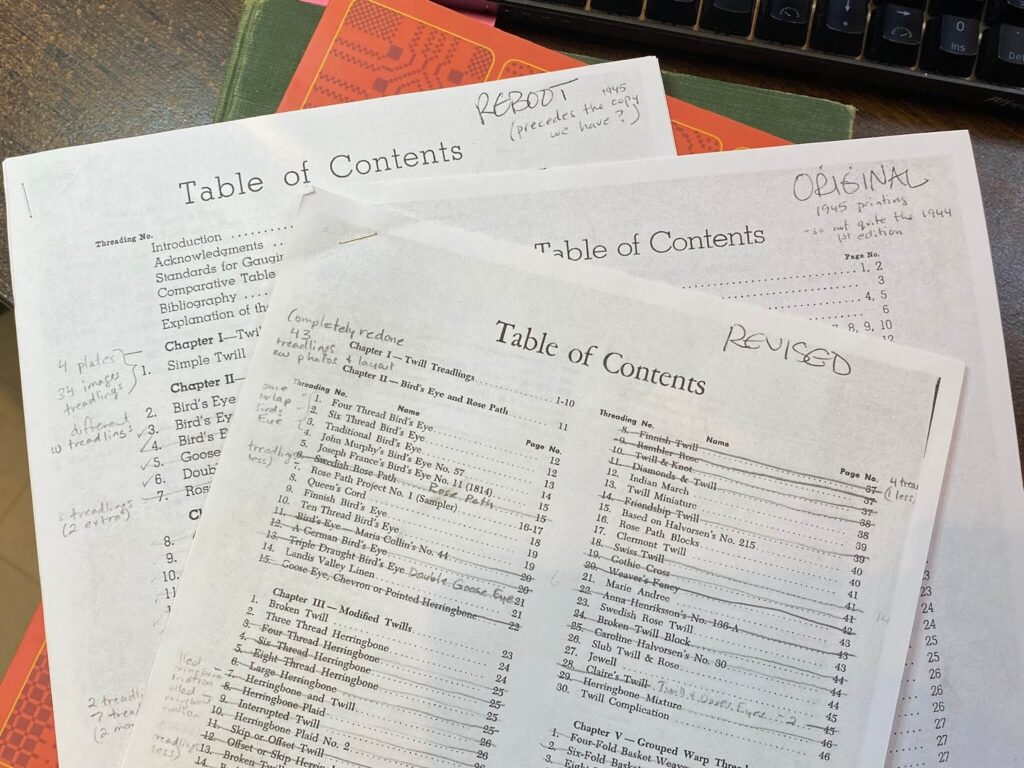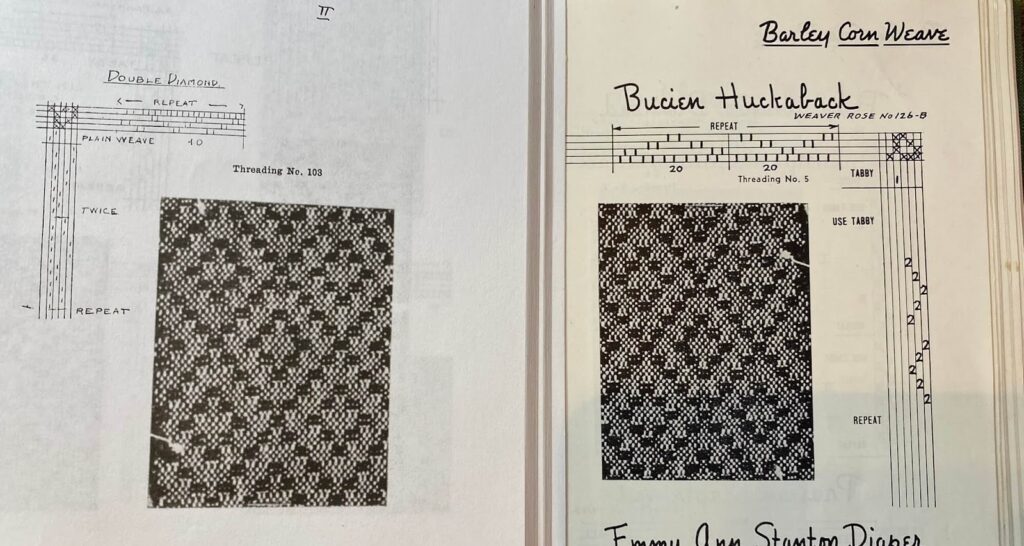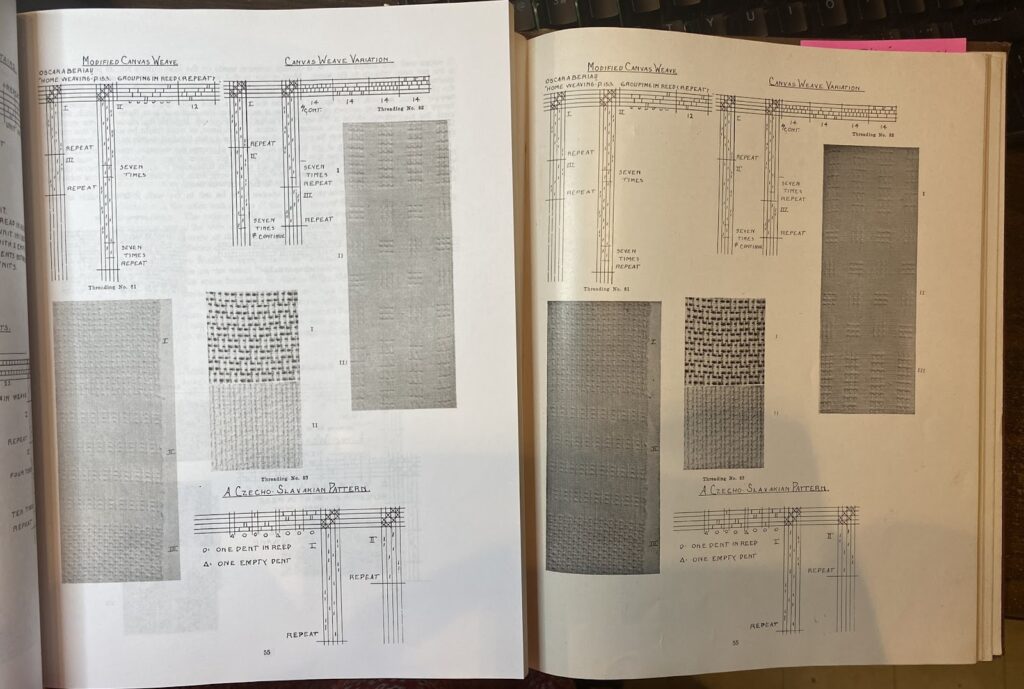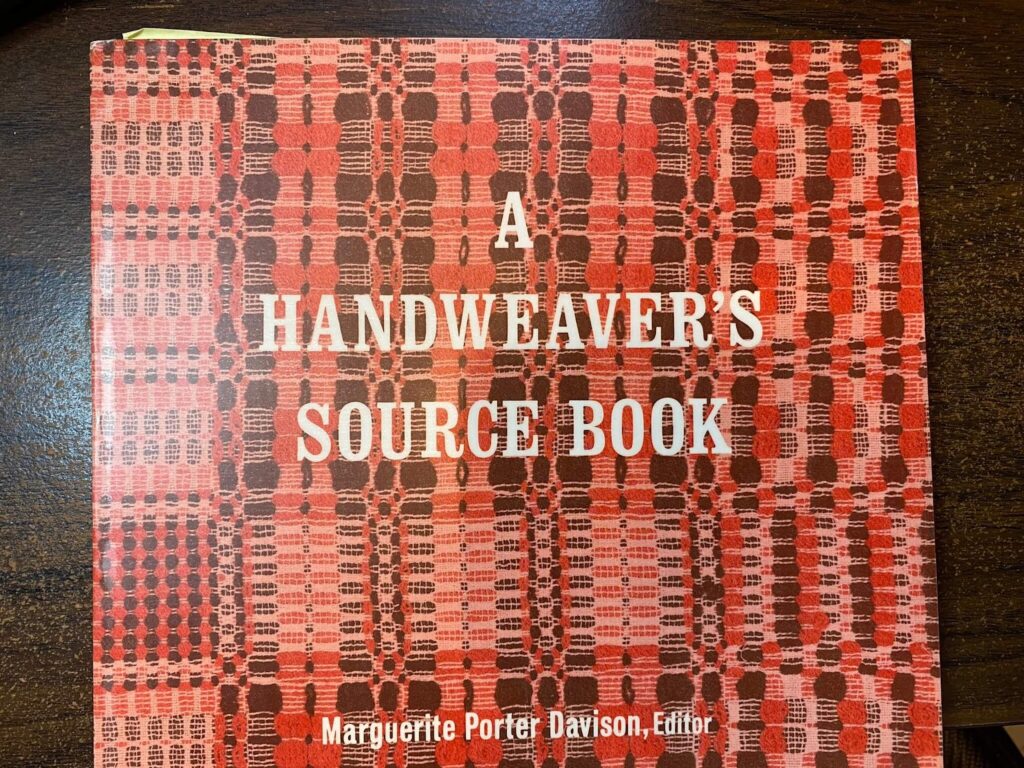A Handweaver’s Pattern Book by Marguerite Davison is VERY popular; many weavers consider it a must-have, especially for folks with four shaft looms. Known as the “Green Book” for its green, hardback cover, it’s one of the best references and draft collections available for four shafts, containing hundreds of drafts in all kinds of different structures, as well as some basic theory related to those structures.
There are different versions of the book, though, some of which are hard to come by and expensive, and others of which are cheap and readily available. To confuse matters even further, the newest version of the book appears to be a significant downgrade from the version before, but it’s also a lot cheaper.
What’s up with that? Why is the new version missing stuff? Should you shell out big money for the earlier version, or save your pennies and buy the new one that’s easy to find?
To answer these questions, my friend Kari Fell and I dug into the book’s printing history and compared all three versions, page by page and draft by draft.

A Handweaver’s Pattern Book- The printing history
The printing history of the book explains why there are (apparently) three different versions, and why the newest version seems like a significant downgrade from the previous one.
1944: The original (brown) version
A Handweaver’s Pattern Book first came out in 1944. Given the scarcity of the war, Davison couldn’t find a publisher so she created her own company, Swarthmore Press, and published it herself. There were four printings of this version between 1944 and 1947.
This version’s hardcover was brown; I don’t know if it ever had a paper jacket; none of the copies I’ve seen have had one.
1950: The revised (green) edition
In 1950, Davison published a revised and much improved version of the book.
Nearly but not quite all of the drafts from the original 1944 version made it into the revised edition, and over 160 new drafts were added. As well, several of the original drafts were renamed, and everything was arranged into new chapters. The overshot section in particular was expanded, from four chapters to seven.
The formatting of the drafts also improved significantly: the notations were made bigger and easier to read, the font changed, etc. The photos were also often enlarged, rotated, or replaced entirely.
Here’s an example of the improvements to readability:

This is a pretty extreme example: most of the drafts in the original version were larger and easier to read than this one.
This revised edition was printed over 30 times up until 2007, always by Swarthmore Press. This is the version that we know as the iconic “Green Book”: its hardcover is green, and so is the paper dust jacket.
2014/1944: The reboot (orange)
Swarthmore Press stopped printing the Green Book in 2007. Then, in November, 2014 another company entirely (Churchill & Dunn) started printing a new version with an orange cover.
Kari and I call this version the “Reboot” because it’s actually an exact copy of the 1940’s era original brown book. It appears that someone has scanned the pages of the original and printed them with a new cover. Even the page numbers are copied directly from the original book. The scanned pictures are a little lighter than the originals; sometimes that’s good, sometimes it makes it even harder to read.
Here’s the same page in the Reboot (left) and the original brown hardcover (right):

That’s why the new version, aka “the orange book” seems like a downgrade from the Green Book: it’s a copy of the book from BEFORE Davison revised it in 1950, without the new layouts, the new typeface, the new photos, or any of the new drafts.
The copyright on the original 1944 version would have expired 50 years after the author’s death, or in 2003, so presumably Churchill & Dunn are taking advantage of this fact and reproducing the book that’s now in the public domain. Whether they have the blessings of the Davison family, we don’t know.
So… There are actually only TWO versions of A Handweaver’s Pattern Book: The original version, printed prior to 1950 or post 2014, or the Revised (green) Edition, printed between 1950 and 2007.
Comparison of the original/reboot and the iconic Green Book
That explains WHY there are different versions, but it doesn’t help you decide which one to buy. The Green Book is hard to find and often very expensive these days – is it really worth shelling out big money, or is the orange book good enough?
The significant points of comparison between the orange and green books are
1. The drafts included,
2. Print quality and readability, and
3. Price!
The Revised Edition has 377 drafts listed in its table of contents. The Original/Reboot has 214. Around 200 drafts appear in both books. According to our direct comparison, 168 brand new drafts were added to the Revised Edition, while 13 drafts from the original version were removed. Some others were expanded on, grouped together, split apart, or otherwise modified.
About half of the drafts in the Revised Edition that are not found in the Original/Reboot are in the overshot chapters. Some notable (read: popular!) examples include Norse Kitchen, Lee’s Surrender, Gertrude’s Fancy, Blooming Leaf of Mexico, and Maltese Cross. If you’re keenly interested in overshot, this could be a major deciding factor for you.
The print quality and readability of the Green Book is much improved compared to the original version. The drafts in the original were harder to read: the notations are smaller – sometimes much smaller! – and the printing is fainter. If your eyesight isn’t great, print quality could definitely be a deciding factor.
The Green Book has become hard to find and is therefore expensive. You’ll occasionally find an affordable copy at an estate sale or used bookstore where the people setting prices don’t realize what they have. Most online vendors do realize, and price accordingly. These days it’s often listed in the US$80-100 range; for a while, people were asking up to $300 per copy! It’s still not unusual to find it priced around $200.
The orange book, on the other hand, is readily available for US$20 ($30 if you want hardcover). When the difference is $20 vs $200, price is obviously going to be a deciding factor for a lot of people!
Which to buy
Which version to buy is partly a question of access (can you even FIND a copy of the Green Book?) but mostly a question of price vs. content. In short, you have to decide whether the additional ~170 drafts and improved readability are worth the extra cost. This isn’t a question anyone can answer for someone else.
If I didn’t have a copy of the book and could get the Green Book for around $80, I’d spring for it. For me, the additional drafts and improved readability would be worth the extra $60. If the only copies available were $200+, though, I don’t think I’d bite. Instead, I’d buy the orange book as a stop gap measure and keep my eye open for an affordable copy of the green book down the road.
The orange book is so inexpensive and the contents so useful that there’s no downside to having more than one copy. Plus, as a paperback it’s easy to have the binding cut off and turned into a spiral bound book (most printing places can do this for you) – and then you could scan or take a picture of the pages and blow them up bigger to make the drafts easier to read.
Watch out for people selling the brown book at Green Book prices! They probably aren’t trying to scam you – they probably just don’t realize that the brown hardcover doesn’t have the same contents as the green hardcover. If you particularly want a vintage copy of the old book, by all means get one with a brown cover. Just be aware that you’re getting the same content and readability as in the 2014 Churchill & Dunn version.
Check out rather than purchase
One last point that might help you decide whether to spring for that pricy copy of the Green Book you’ve found: A Handweaver’s Pattern Book by Marguerite Davison is (usually!) available to check out for free from the Internet Archive.
The Internet Archive is a library, so the book isn’t always available, but there are multiple copies so you probably won’t have to wait long. You can check the book out for up to a week at a time, during which time you’ll be able to read it on your screen.
Alas, the Internet Archive was brought down by a denial of service attack earlier this month, and they have yet to resume their library services. I fervently hope that this situation is temporary and that the books will be available to check out again soon.
Nov 21, 2024 update: Yay! Books are once again available on the Internet Archive site! You can find A Handweaver’s Pattern Book here.
Other libraries also have copies of the Green Book, and patrons of one library can often check out books from other libraries using interlibrary loan. It’s worth checking your own public library to see if they have a copy or can get one for you. If you have a weaving guild with a lending library within reach, that’s another option for accessing the Green Book without shelling out very high prices to own a copy of your own.
The other orange book
Davison wrote a second book, A Handweaver’s Source Book, which was published shortly after her death in 1953. The color of its cover varied but at least some versions were published with a red or orangey color, so people sometimes refer to it as “the orange book” or “the red book.”

When someone talks about the “orange book,” you should clarify whether they mean A Handweaver’s Source Book or the new Churchill & Dunn version of A Handweaver’s Pattern Book.

Interested in more weaving resources, check out Tien’s post, Product Review: Palette Scout by Zollie
